If you’re like me, then your name is Philippe and you live in California.
If you’re slightly less like me, then you probably used to do the whole fake card thing, stopped, but then only recently got back into it. Well, what better way to get back into making fake cards than by going back to the site that started it all! Well, I mean, the modern version of that site, not the old version; I don’t update that site anymore, so that info isn’t very useful now.
As I’m sure you might have noticed, the card game has changed A LOT since the Wizards of the Coast days. Pokémon LV.X? BREAK Evolutions? Ultra Beast?? What the smeg is goin’ on here? It’s kinda scary stuff, almost like an daunting task to want to get back, right?
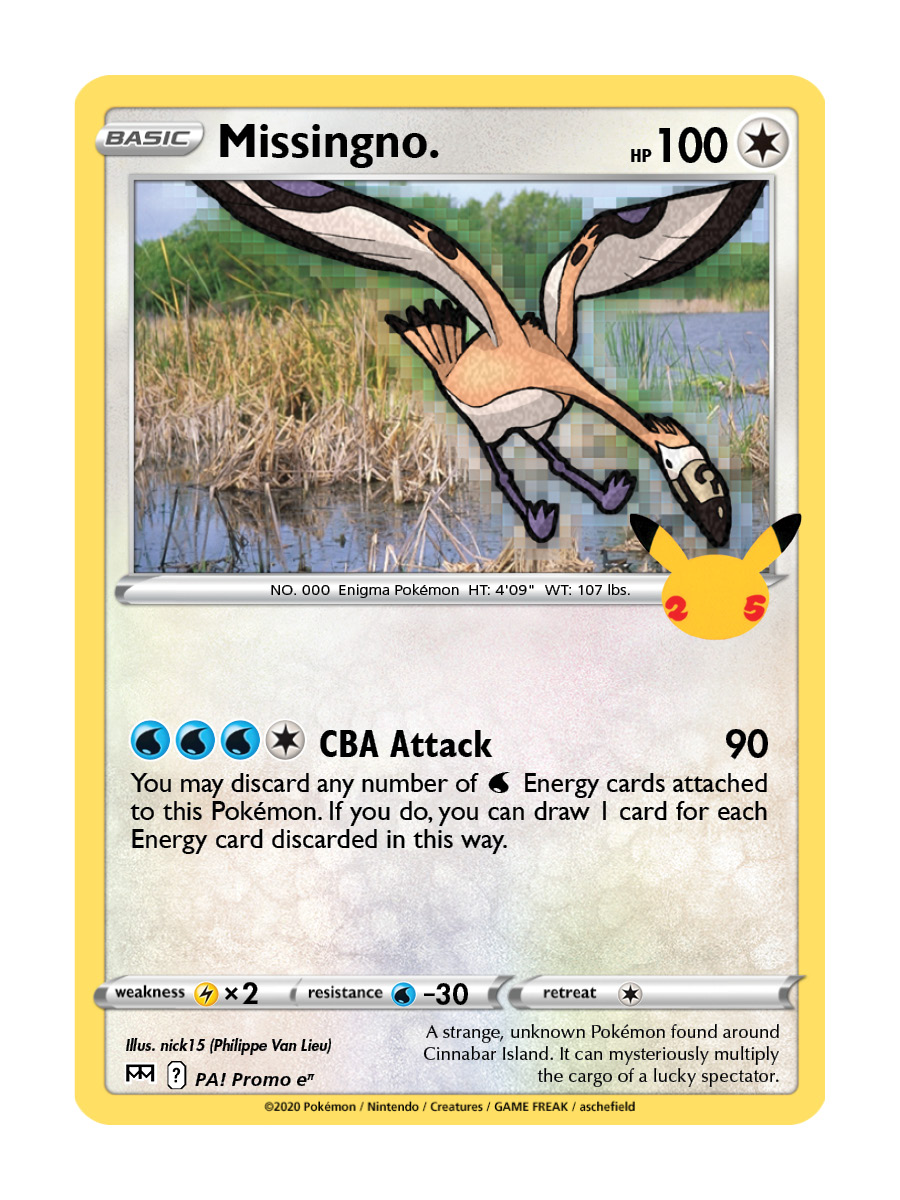 Well, don’t worry, your ol’ pal Uncle Nick15 is here to help explain everything. Hopefully by the end of this you’ll get a good idea of the kind of stuff you can do with this game and hopefully inspire you in new and exciting ways. That said, this page is still a work in progress, but I’m planning on covering all the different card types and styles. Anyways, let’s get crackin’!
Well, don’t worry, your ol’ pal Uncle Nick15 is here to help explain everything. Hopefully by the end of this you’ll get a good idea of the kind of stuff you can do with this game and hopefully inspire you in new and exciting ways. That said, this page is still a work in progress, but I’m planning on covering all the different card types and styles. Anyways, let’s get crackin’!
Before I get into the weeds, I’m gonna make a quick assumption here: I’m gonna assume that you already had SOME degree of faking experience from back in the day, and were at least somewhat familiar with the kinds of blanks and materials we used back in the day. But that said, I’m also going to presume a baseline level of experience with faking which ends right around when PA! ceased updating in 2004, or maybe even before than, like during the end of the Wizards of the Coast era (around the Card-E era). So this information might be perfectly tuned to your level of experience, but it might also be too new or too old. I can’t account for everyone’s experience, but I’ll still try to keep things more generalized as possible for anyone trying to get back into faking after being out of the loop for so long.
Overview
This page breaks down card design into three broad categories:
- Card Styles — card styles are the main category of card design, which change every few years with the release of a new video game generation
- You can’t mix-and-match card styles; they are ultimately the core, fundamental category of blank design
- So the Original, Card-E, Diamond/Pearl, etc. blank designs are all “Card Styles”
- Card Types — card types are sub-categories of card designs, which technically can be a part of ANY card style
- Although many card types—such as Pokémon-ex, Pokémon-EX, Pokémon VMAX, etc—only appeared in a certain card style era, technically they can be a part of ANY card style.
- You’ve likely seen this before: Gym Heroes and Gym Challenge had “Owner’s Pokémon” card types which used the Original Card Style. So basically, unlike card styles, card types can be mixed-and-matched with multiple other card types.
- Ways to Evolve — because of these various card styles and types, various game and design rules have come along which affect how and IF cards of a certain style or type can even evolve to begin with.
- For example, Pokémon-ex type Pokémon can evolve from a non-ex Pokémon, while Pokémon-EX type Pokémon are ALWAYS Basic Pokémon cards but can in turn evolve into MEGA Pokémon-EX type Pokémon.
These core categories form the basis of the sections of this page:
- Card Styles and Blanks: this section covers all of the different card styles and therefore blank designs that have come about since the “EX blanks” that we originally released. As you can imagine, the cards have been redesigned MANY MANY times over the years, but the core elements have always remained the same.
- Card Types and Concepts: this section focuses more on the various card types that have existed over the entire history of the game, like Pokémon-ex, Pokémon PRIME, Ultra Beast Pokémon, etc… the idea is to show you what they looked like relative to their baseline blank in case you wanted to make those kinds of cards using other blanks (like a Base Set-style Mega Pokémon-EX)
- Ways to Evolve: this is more of a subsection to the Card Types and Styles section, covering the ways those card types were intended mechanically interact with one another.
That said, all of this is here to serve three major purposes:
- one, to get old timers up to speed on everything they’ve missed out on since the good ol’ days
- two, to get fakers acclimatized to the rules in order to maintain a high level of authenticity (and therefore believability)
- three, to learn the rules to therefore know how to properly break them
The latter is one of the driving forces of my own artistic career, which I first realized after reading about the concept from Calvin & Hobbes’ creator, Bill Watterson; he basically said that you can’t break the rules until you know what those rules are.
Card Styles and Blanks
So as you might remember, we had blanks covering Base Set up until the Nintendo eReader EX-era Blanks, which covered the Card-E era from EX: Ruby & Sapphire up to around EX: Team Magma vs Team Aqua. But since then, many new card blank types have come and gone. I’ve also included a card which best exemplifies the blank; they’ve all been pretty much sourced from PKMNcards.com or Bulbapedia, although some of them were ones I created myself (such as any Japanese-language examples). For the sake of getting a good idea of what the card blank looks like, I’ve tried to choose cards which have a good variety of open space but also a variety of attacks, but I’ve also stuck with a single type so you can see how the same type is reflected across the different types. I’m also covering each blank in broad strokes focusing on its baseline design, so I won’t cover some of the more nuanced subset blank designs, such as Team Magma/Aqua versions of the blanks. Those details will be in the following “Card types and style” section.
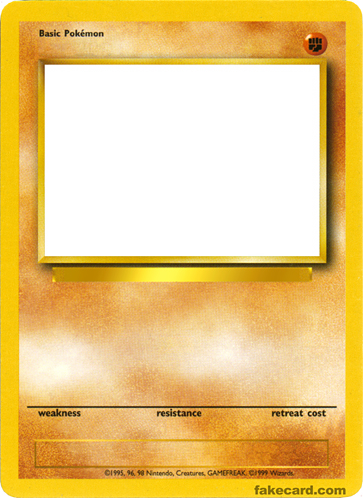  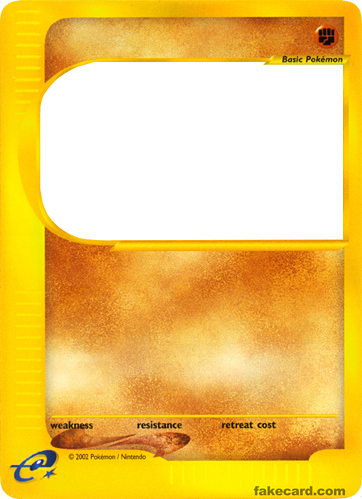  |
Everything beforehand…
Just as a friendly reminder, these were the blank card design styles we had back in the day:
- Original Style
- Specifically the Shadowed style seen in Unlimimted Base Set, Jungle, Fossil and Team Rocket
- Technically the Shadowless style (first seen in 1st Edition Base Set) is its own blank, and NO ONE ever actually made it… but I did! Check them out here!
- The “Gym” Style seen in Gym Heroes and Gym Challenge is also technically not a blank style, but rather a card type known as Owner’s Pokémon (see relevant section below)
- Neo Style
- This card style had the swoops and extra pointy bits all over the place.
- Seen between Neo Genesis and Neo Destiny.
- Card-E Style
- Originally used between Expedition Base Set and Skyridge, this card style “evolved” the Neo Style, but also had extra space in the left and bottom sides of the card for the DotCode bars for scanning in a Nintendo eReader.
- This was the last of the Wizards-era card styles
- EX Style, intra-eReader Version
- The first of the Nintendo-era card design, this style kept at least the extra space on the bottom side of the card for more DotCode features.
- Used between EX Ruby & Sapphire until EX Team Aqua vs Team Magma, it is effectively the same card design as the following EX Blanks, post-eReader, but had some minor but significant enough differences to separate the two.
|
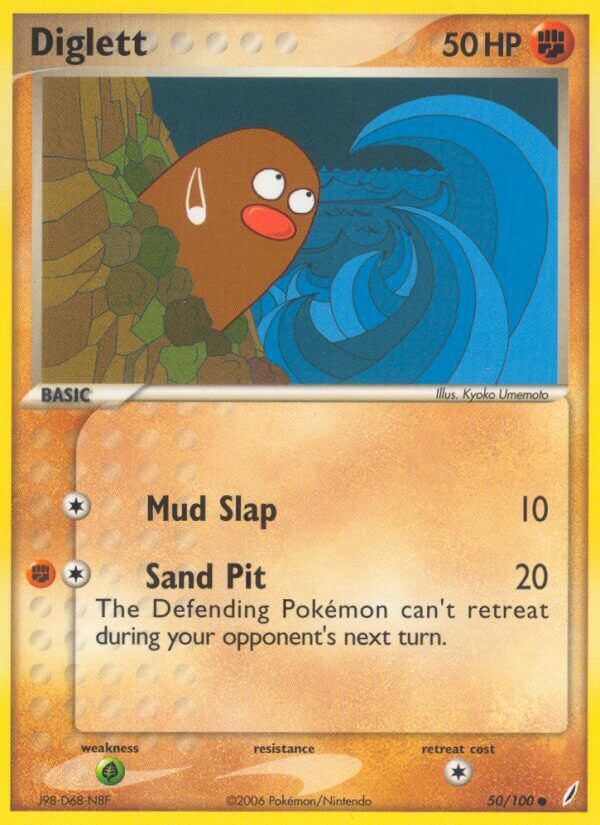 |
EX Blanks, post-eReader Version
- Between EX Hidden Legends and EX Power Keepers
- It’s important to note that despite its similarity to the intra-eReader EX Blanks, there have been enough changes made here and there that the post-eReader EX Blanks are truly and effectively a new blank style.
- Since these were based on the eReader-based EX blanks, which had all of the typical PokéDex info for the Pokémon stored within its Dot Code bar located on the bottom of the card, these cards lack any PokéDex info. Instead the bar which would have been used for its PokéDex stats simply stores the Illus. credit.
- They also lack the Pokémon’s Level. They do, however keep the odd “9-character code” found on the bottom-left of every card.
- Another minor change was the removal of the yellow shading next to the Pokémon’s name
- Evolution cards no longer use “Put XXXX on the Basic/Stage 1 Pokémon” text, simply opting for “Evolves from YYYY”.
|
 |
DP Blanks
- Between Diamond & Pearl and DP Arceus
- These blanks mark the return of the classic PokéDex info, complete with Height/Weight info and flavor text, as well as the Pokémon’s Level. However, several changes have been made to this:
- The flavor text only has the PokéDex entry, and is now placed between the attacks and the “Weakness/Resistance/Retreat Cost” bar.
- The Level has been moved up next to the Pokémon’s name, while its National PokéDex number is placed it is infobar underneath the artwork.
- Furthermore, the flavor text uses a completely new font, the first time a new typeface has been officially used in the TCG in… maybe ever!
- The infobox is rearranged slightly: it’s now has the aforementioned National Dex number, then Pokémon type, then “HT” and “WT” instead of “Height” and “Weight”. Finally its values are listed in full and not rounded, so 1’04” and 22.5 lbs. versus 1’4″ and 23 lbs.
- They keep the “Neo Swoops” from the EX blank.
- The HP switches to the format it’s currently in, with the letters “HP” preceding the value (eg HP X0), and the size of “HP” is quite a bit smaller
|
 |
HGSS Blanks
- Between HeartGold & SoulSilver and Call of Legends
- Generally similar to the DP Blanks, except that both the Pokémon’s Level and the “Neo Swoops” have been removed.
- Also technically the attack icon designs were changed starting with this set (the most obvious change is with the Grass and Water symbols, which got wider)
|
 |
BW/XY Blanks
- Between Black & White and XY Steam Siege
- Technically they were originally just “BW Blanks”, but I guess TPCI didn’t feel the need to update the style with the release of XY.
- These blanks tap into some of the look-and-feel of the original Base Set blanks, from both the Japanese and Western POV:
- the Weakness, Resistance and Retreat cost (now simply “retreat”) are placed on the left, while the PokéDex entry is on the right
- the borders are now a solid yellow color and not a gradiant for the first time since Neo Destiny (this non-gradiant style doesn’t apply to “Team Plasma” cards, however)
- Levels remain non-existant.
- “Poké-Power” and “Poké-Body” effects are no longer used, changing to “Ability”, which remains in use to this day.
- The copyright text on the bottom of every card has been reduced from “© 20XX Pokémon/Nintendo” to simply “© 20XX Pokémon“.
|
 |
Evolutions Blanks
- Used only in the Evolutions set, which was a sort of modernization of the Base Set-style blanks
- Similar to how the BW/XY Blanks tapped into the look-and-feel of the original Base Set blanks from Japan and the West, this set does it even further… but also keep a lot of modern changes as well.
- For example, the infobox keep the format it’s been using for quite some time, with the Pokémon’s National Dex number placed in it. Similarly, Levels return and are placed on the same line as the Name and HP, but are placed closer to the HP
- On the other hand, HP is listed as “X0 HP” like it did back in the day. Furtermore, evolution cards have the “Put XXXX on the Basic/Stage 1 Pokémon” like it used to.
- Like both original Base Set designs, attacks are separated by a line, the first (and only) time since the Card-E sets
- Unlike neither, however, the “Basic Pokémon” text from the Base Set era is replaced with a gold diamond with simply “BASIC” inside it.
- For this set only, “retreat cost” returns, instead of simply “retreat”.
|
 |
SM Blanks
- Between Sun & Moon and SM Cosmic Eclipse
- This set changes up a lot.
- the type background is completely new
- the weakness/resistance/retreat info returns to a single line, versus in the bottom-left corner
- flavor text is placed on the bottom right, beneath the W/R/R bar
- the illustrator, set icon, card number and rarity is placed on the bottom left, also beneath the W/R/R bar
- there is an otherwise complete lack of horizontal lines
- once again, Level is removed
|
 |
SwSh Blanks
- Covers sets between Sword & Shield and Crown Zenith
- That said, the SwSh blanks seem to be only a slight variation of the SM blanks, however some minor but significant changes were made:
- a regulation mark was added to the card, placed in between the set icon and the card number
- both attack energy and Pokémon-type icons have a white border around them
- the attack energy backgrounds were also changed slightly
- the copyright text has expanded from “© 20XX Pokémon” to “© 20XX Pokémon / Nintendo / Creatures / GAME FREAK” and placed within the card’s border.
|
 |
ScVi Blanks
- Current style of blanks, starting with Scarlet & Violet
- The ScVi blanks change a bit, but also very little:
- it uses the same type backgrounds
- it adds a light overlay to the gametext area
- changed the border from yellow to silver (a long time coming)
|
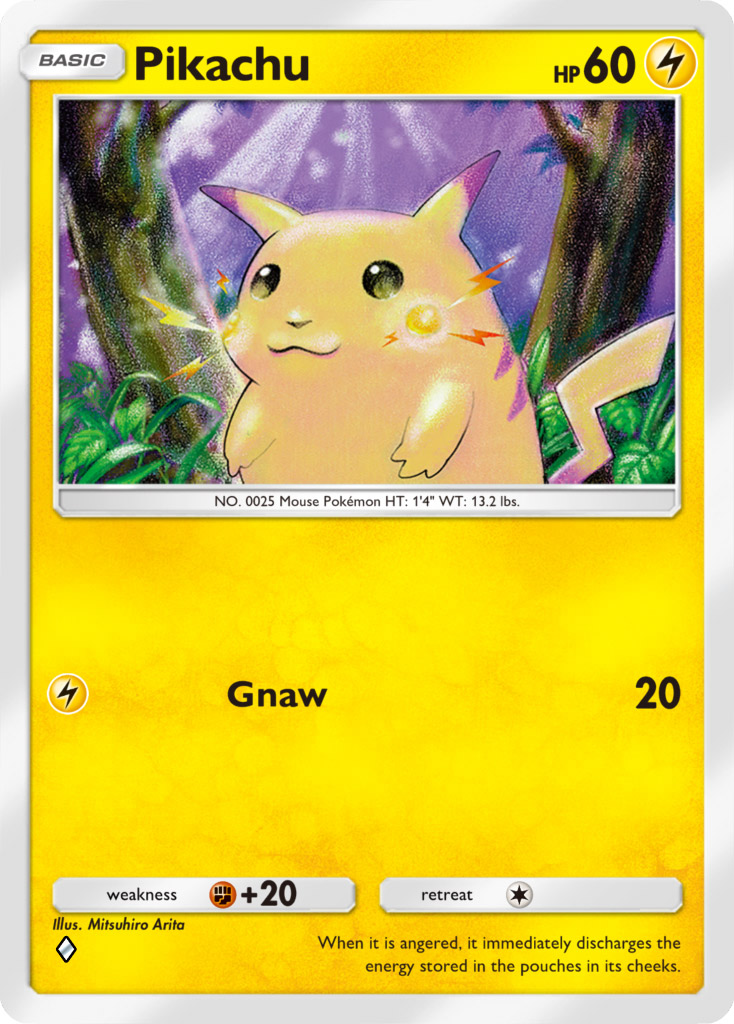 |
Pokémon TCG Pocket (PTCGP) Blanks
- Covers cards unique to the Pokémon TCG Pocket mobile game
- They’re basically the Sun/Moon design, just tailored to suit the rules of Pocket
- They also use the attack energy backgrounds seen on Sword/Shield
|
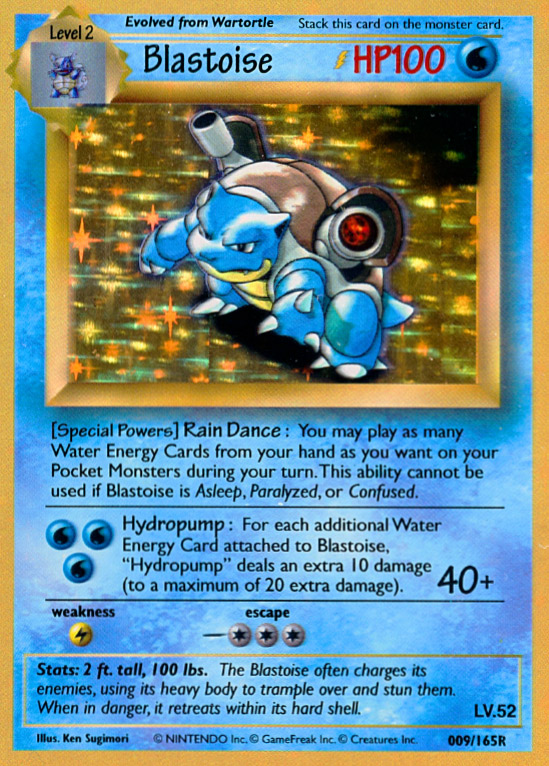 |
BONUS! Wizards Alpha Blanks
- Technically this blank was NEVER used, as it was created before Wizards of the Coast officially got the license to make the Pokémon TCG. However, its existence comes from Wizards trying to prove themselves to Nintendo… and it clearly worked because they ended up getting the license in the end.
- You can read my post about its entire story, covering where this card came from, where it suddenly reappeared from, and every other tidbit worth sharing about it.
- Some of the more significant differences between the “Wizards Alpha” style and subsequent card styles include (but are not limited to):
- Card Set Symbol placed next to the HP (that lightning bolt was the symbol used on the original Japanese version)
- Multiple keyword differences (such as “Level” vs “Stage”, “Escape” vs “Retreat (Cost)”, and “Evolved from…” vs “Evolves from…”)
- No Stat Infobar, with the Pokémon’s stats placed in the flavor text box
- Use of a completely different font—Tekton Pro—for the Pokémon’s name, its
Pokémon Special Power and Attack name, as well as its Attack damage value
- Two lines denoting that it’s
Stage Level 2, versus all both Stage 1 and 2 Evolutions having only one line (this 2-bar format would later be used starting in the Neo-era)
- Although this blank was never used on any officially released Pokémon TCG card, we are definitely working on releasing a complete set of blanks inspired by the sole prototype Blastoise! We hope to release it soon.
|
All of these blanks can currently be downloaded at PokemonCardResources, except for the SwSh Blanks, which you can download here on PA! (courtesy of aschefield101). That said, we’ll be focusing on making new fakes using the SwSh blanks, so maybe download the SwSh Blanks pack when you’re ready to start.
Card Types and Concepts
Whew doggies! A lot has changed since the good ol’ days… the most we had to contend with was Pokémon-ex, and those were wild new concepts back then! But now there’s so many different types… where does one begin??
Well fortunately, in an effort to even help myself understand what kinds of card types exist and are worth making fakes of, I’ve gone through every single set and documented all the different card designs which might complicate things a bit more than your classic “Basic > Stage 1 > Stage 2” card. I will say, however, that despite all these wild varities and concepts, that classic “Basic > Stage 1 > Stage 2” style remains the backbone of the game… so if you remember how to make cards in that format, then you’re already ahead of the game relative to someone else making fakes!
But anyways, here’s my comprehensive guide to the various card types. To clarify, each entry is formatted like:
- Set Name: Card type/feature
- Sometimes the “Card type/feature” name will have a link, usually to Bulbapedia and an article that I may or may not have had help in writing
- This is where I’ll explain what this type or feature is or does
- DESIGN: this is where I’ll explain what you need to consider when actually designing such a card (such as requiring extra icons, change of colors, etc)
And now:
  |
Team Rocket, Neo Destiny: Dark Pokémon, Light Pokémon
- Dark Pokémon have weaker HP but more powerful attacks
- Light Pokémon have higher HP but weaker attacks and more beneficial abilities
- Nothing about these cards technically forces them to be this way, this is rather a design choice made by R&D.
- DESIGN: uses different color card elements (anything gold is instead dark copper or light cream for Dark and Light Pokémon, respectively)
|
 |
Gym Heroes, Gym Challenge: Owner’s Pokémon, 1st Version
- No general benefit, but they can only evolve from the Owner’s own Pokémon
- Allows you to also have another set of your favorite Pokémon
- This idea would be resurrected in the Japanese-only Pokémon-VS set, and then again in English during the Diamond/Pearl-era as Pokémon SP, but it would never be used again after that.
- DESIGN: uses Gym-style blanks plus Owner’s badge icon instead of flavor text
- While nearly all Owner’s Pokémon don’t look any different from any other card, Rocket’s Pokémon use the “Dark Pokémon” card elements
|
 |
Neo Destiny, Shining Legends: Shining Pokémon
- Always Basic, and you can only have 1 of the same Shining Pokémon in your deck. Well, at least that was the case originally. The revised Shining Pokémon introduced in S&M Shining Legends lacks this ruling.
- Can have more powerful attacks, at least in theory
- DESIGN: no design considerations
|
 |
Pokémon-VS: Owner’s Pokémon, 2nd Version
- Similar to the Owner’s Pokémon in the Gym sets, these Owner’s Pokémon had no general benefit by being an “Owner’s Pokémon”, other than allowing you to have more of your favorite Pokémon in your deck since they’re technically not just plain ol’ “normal” Pokémon.
- However, unlike the Gym-era Owner’s Pokémon—but like the later Diamond/Pearl-era as Pokémon SP—all of these Pokémon-VS era Owner’s Pokémon are Basic Pokémon, regardless if the Pokémon itself was an Evolution or not.
- Finally, like all Owner’s Pokémon, there is a badge with the Owner’s own artwork placed on the card; in this case the badge placed in the bottom-right corner of the card art frame, vertically aligned with the PokéDex Stat Infobox. The later DP-era Pokémon SP version of Owner’s Pokémon would replicate this format.
- DESIGN: this card type never appeared in English, so I can only make guesses on some of the way the card was designed. That said:
- The card overall still uses the Card-E card style, except for the use of a “VS” logo in the bottom-left corner of the card. However, if you make one of these cards, you may just want to ignore that change and leave the normal “e★” icon
- The Owner’s icon is placed inside a slanted ellipse, with the character’s neck and shoulders cropped inside a rectangle… but otherwise has no other special considerations.
- The Japanese has the Owner’s name in a smaller font-size than the Pokémon’s name, but it has ALWAYS done that. The English version would therefore keep the Owner’s name the same size as the Pokémon’s name, albeit making the entire name narrower in width if needed to fit it all into the card name area.
|
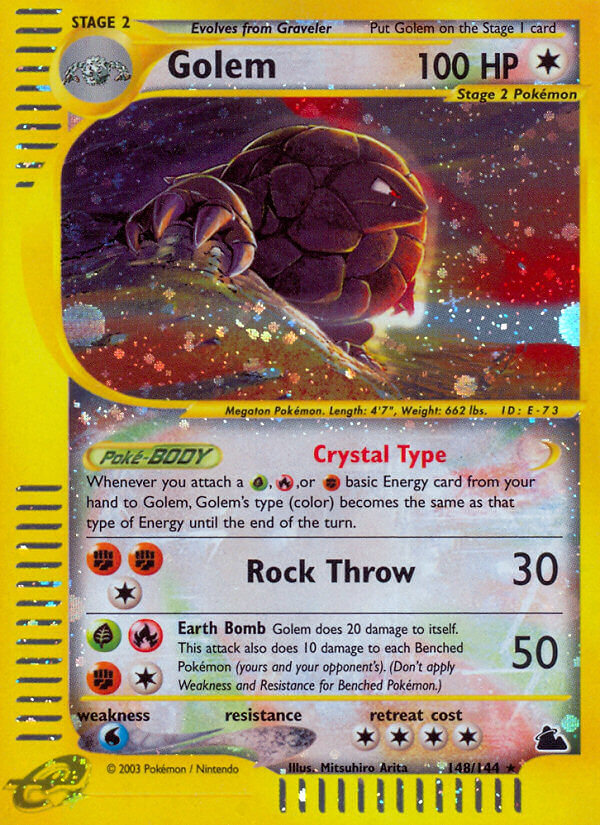 |
Aquapolis, Skyridge: Crystal Pokémon
- Colorless types, evolves as it normally would (as opposed to being Basic Pokémon)
- All have “Crystal Type” Poké-BODY which allows you to attach one of three specified Energy types in order to change that Pokémon’s type.
- Uses multi-Energy type attacks based on the three Energies in its Crystal Type Poké-BODY
- DESIGN: has minor “crystal” effect on the outer periphery of the card
|
 |
EX/ADV Block: Pokémon-ex
- Evolves as they normally would (as opposed to being cards of Evolution Pokémon at the Basic Pokémon stage)
- Has relatively overpowered attacks as well as increased HP (theoretically up to double the normal max HP of 120)
- Has the drawback of allowing opponents to draw two prizes if they knock out a Pokémon-ex, may also have double weaknesses too
- Unrelated to Pokémon-EX, despite the similar name
- DESIGN: uses holoborder instead yellow border, adds Pokémon-ex notice, uses unique “ex” icon
|
 |
EX Team Rocket Returns: Pokémon ☆
- Similar to Shining Pokémon from Neo Destiny, but distinct from them.
- Like and Unlike Shining Pokémon, you can only have one Pokémon ☆ per deck, but ANY Pokémon ☆, not just of the same name.
- Otherwise there is no special concept behind it.
- DESIGN: uses unique “☆” icon
|
 |
EX Delta Species: δ Delta Species Pokémon
- Delta Species Pokémon had types which were different from what they normally were, such as a ZL-type Metang (which are normally ZM-type).
- They were otherwise no different than they normally would be.
- DESIGN: had a unique “double-helix” artwork border, and the evocon box was shaped like a δ, something that even Basic Pokémon had. Furthermore, the phrase “δ Delta Species” was placed between the Pokémon’s name and HP.
|
 |
Diamond & Pearl: Pokémon LV.X
- Needs to evolve from an Active Pokémon of the same name. For example, Empoleon LV.X needs to be placed on top of a normal Empoleon that is your Active Pokémon. It can use both the attacks and powers on its LV.X form as well whatever attacks and powers existed on the stage below.
- Does not allow 2 prizes to be drawn when KO’d like Pokémon-ex.
- Its main drawback is the fact that, technically, its name isn’t “Pokémon LV.X”, but rather simply “Pokémon”, of which its Level is “X” instead of whatever number it would have otherwise been given. So, the Empoleon LV.X above is simply named “Empoleon”, and since you can only have four cards of the same name, you can only have, say, two Empoleon and two Empoleon LV.X. Of course could COULD have 1 Empoleon and 3 Emploeon LV.X… but what are the other 2 going to evolve from? And if you have 3 Emploeon and 1 Empoleon LV.X… well that’s kind of a waste.
- I guess this was the idea: it was a self-limiting mechanic.
- DESIGN: If I utilize this with my Neo Redux blanks, then it’s going to have to use the Baby card. However, it will say “Put onto (Pokémon)” in the rules text box, and the type box that would usually say “Basic Pokémon”, etc, will say “Level-Up Pokémon” instead. Or something.
- Also if I do any kind of “Search for a Pokémon card”, consider that a LV.X card is NEITHER a Basic nor Evolution card.
- I probably won’t need to create a special “LV.X” icon, but I may write “Lv. X” in the flavor text box.
- Finally, the LV.X rule text will be inside the originally Baby rules text
|
  |
Diamond & Pearl: Free Attacks
- Basically, it’s a free attack! No energy cost required.
- This concept started in DP and has been used on-and-off until at least the 2019 set, Cosmic Eclipse (on Alolan Ninetails, for example).
- DESIGN: The look of this has changed over the years; if you want to use it, consult the symbol sheet for the blank style you’re using. If you want to use this on a blank style that never used it (such as the old skool “Base Set” style), then you can use any existing style, people will get the idea.
|
 |
Mysterious Treasures: Held Items
- Pokémon Tools have always existed, but these are actually special effects added to the card itself.
- DESIGN: I’ll probably just use the Baby box.
|
 |
Platinum: Pokémon SP
- These are the successor of Owner’s Pokémon. They are similar to the way Owner’s Pokémon were utilized in Pokémon-VS, in that they were all Basic Pokémon regardless if the Pokémon itself was an Evolution or not.
- DESIGN: All Pokémon SP have three specific features:
- “SP” icon in the lower-left corner of the artwork frame
- Owner’s icon (as a circle) in the lower-right corner of the artwork frame; this is similar to the format used in the Pokémon-VS style of Owner’s Pokémon (see above).
- Suffix icon after its name. There were six icons overall during the DPP-era
- G for Team Galactic; the G is the Team Galactic icon
- GL for Gym Leader; the GL is a stylized “GL” block
- 四 for Elite Four; the 四 is a stylized version of the character
- C for Champion(‘s Pokémon)
- FB for Frontier Brain(‘s Pokémon)
- M for Movie(‘s Pokémon); the M is a stylized Pikachu tail
- If I decide to use this style, it will only to make a Gym Leader or Elite Four Pokémon and as a Basic Pokémon card.
|
 |
HeartGold & SoulSilver: Pokémon Prime
- These are essentially mechanically no different than any other kind of card.
- DESIGN: All Pokémon Prime cards are designed with:
- a special artwork border that looks like it’s exploding outwards; the artwork itself is very close-up and highly contrasted
- the use a golden card name
- the card’s actual gameplay abilities are generally stronger relative to other Pokémon of the same name.
|

 |
HeartGold & SoulSilver: Pokémon LEGEND
- These are special two-card cards; they require combining two separate cards to use.
- When they are knocked out, the opponent can draw two cards.
- Pokémon LEGEND cards tend to be of two different Legendary Pokémon uniting, and as such tend to have two types and two weaknesses (and maybe two resistances as well), but there is no requirement for this (in fact the first Pokémon LEGEND cards utilized only one Pokémon).
- In either case, their HP can be over 120.
- DESIGN: All Pokémon LEGEND cards utilize:
- a unique “LEGEND” icon
- gold card name
- super huge card art, so huge that it in fact interferes with the card’s attacks and other abilities; the text is placed haphazardly as if the Pokémon’s very presence and force of nature threw them into chaos
- The first (top) card has the card’s name, HP and type placed along the long left side of the card. The second (bottom) card has only the card name and type placed along the usual top side of the card. When placed together, both cards are rotated clockwise, with its usual left side of the first/top card now as the top, and the second/bottom card’s original top placed sideways on the bigger card’s lower-right side.
|
 |
Black & White Next Destinies: Pokémon-EX
- Like the EX/ADV-era Pokémon-ex, these are powerful Pokémon which allows your opponent to draw two prizes if they’re KO’d.
- Yes yes, the kinda messed up in the naming here. They sound like the EX/ADV-era Pokémon-ex, even having the same “2 Prize KO” ruling, but they are technically completely different card types. For example, cards which reference Pokémon-ex cards (eg Mr. Briney’s Compassion) don’t consider Pokémon-EX cards as such, and vice versa. This means a card like Mr. Briney’s Compassion can pick up a Pokémon-EX in play, simply because it’s NOT a Pokémon-ex.
- Unlike the original Pokémon-ex, however, all Pokémon-EX are Basic Pokémon, regardless if they actually are normally Basic or are instead fully evolved Pokémon (like Blastoise, Charizard, etc).
- This is, however, a solely thematic choice; there is nothing barring Basic Pokémon from being a Pokémon-EX, such as Pikachu-EX or Kangaskhan-EX.
- But just because Pokémon-EX are Basic Pokémon, they can’t evolve; Pikachu-EX can’t evolve into a Raichu, since its name is “Pikachu-EX” and not “Pikachu”. This themeatic choice to not evolve changed with the release of Mega Pokémon-EX (see below).
- DESIGN: the only design concern is the EX icon. I MAY place the ruling text in the flavor text box instead, however.
- They also produced standard and full art versions
|
 |
BW Boundaries Crossed: ACE SPEC cards
- Trainer (Item) cards which are limited to one per deck.
- DESIGN: requires the “Ace SPEC rule” added, plus the words “ACE SPEC” written down each side. The Trainer card is also darkened relative to it’s normal appearance.
|
 |
BW Boundaries Crossed: Team Plasma cards
- This is mostly just a designation or card category, allowing you to search for or otherwise target “Team Plasma Pokémon”
- I’m not sure if I will use this, but who knows?
- Maybe I’ll genericize things? At the very least I’ll still do an example of this.
- This is also slightly different from how “Team Such-and-Such” cards were made, because in the past they had specifically different names, eg “Rocket’s Mewtwo” or “Team Aqua’s Sharpedo”. For Team Plasma, they are simply their normal names, meaning a Team Plasma Flareon can evolve from ANY Eevee card.
- DESIGN: Cards with blue borders, a “Team Plasma” notice below the HP, and a “Team Plasma” watermark in the card text
|
 |
XY: Mega Pokémon
- Technically all Mega Pokémon are also Mega Pokémon-EX.
- Although these appeared only on Pokémon-EX cards (ie Pokémon-EX evolve to Mega Pokémon-EX), technically it doesn’t seem like it needs to be limited to Pokémon-EX cards. Anything can Mega Evolve, it’s ruling is separate from the Pokémon-EX ruling.
- Mega Pokémon are special evolutions and therefore have a special ruling: when you Mega Evolve a Pokémon, your turn ends.
- Prior to this, all Pokémon-EX could not evolve. Bear in mind, this wasn’t a ruling against Pokémon-EX but simply as a choice to simply not make any cards that evolve from Pokémon-EX.
- DESIGN: Mega Pokémon have a special “M” icon placed in the front of their name, for “Mega”.
|
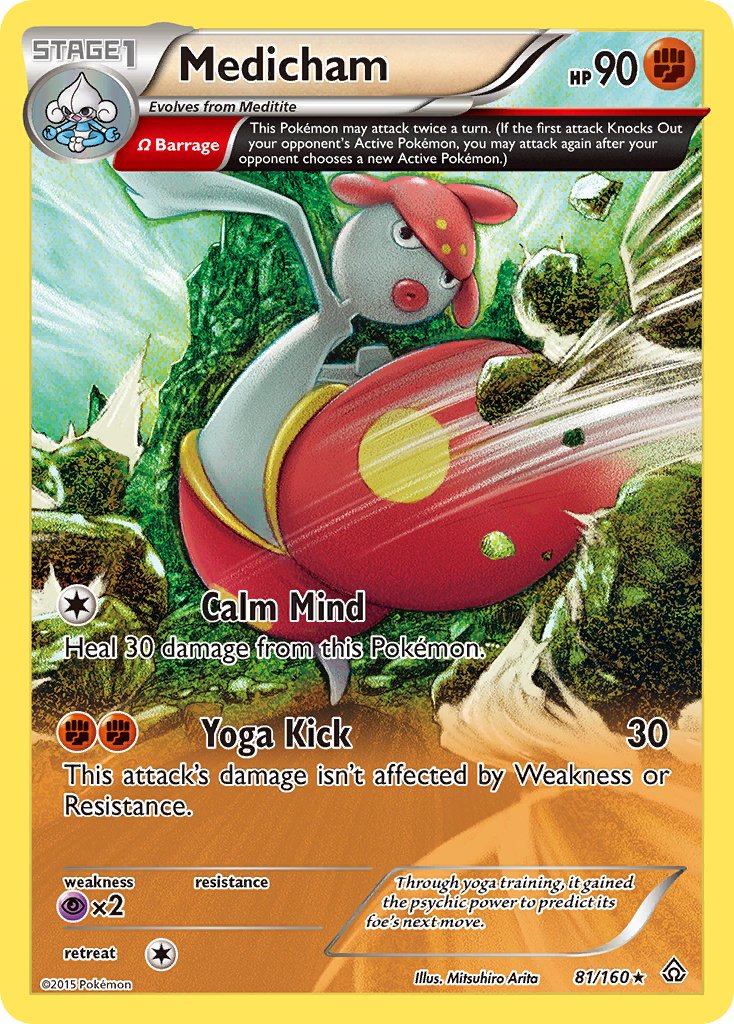 |
XY Primal Clash: Ancient Trait
- This is more of a special effect added to each Pokémon that allows you to do extra effects.
- DESIGN: I’ll probably just use the Baby box, albeit color coded.
|
 |
XY BREAKthrough: Pokémon BREAK Evolutions
- Similar to LV.X, BREAK Evolutions share the same attacks and abilties of its previous evolution, but also the weaknesses, resistances and retreat cost. They are also placed over its previous evolution card, albeit sideways.
- Unlike LV.X, BREAK Evolutions ARE evolutions. They are also differently named.
- DESIGN: uses a special “BREAK” icon after its name, as well as a special rule box below its HP. Extra “stripes” are placed in the bottom corners of the card, and the Pokémon is colored in gold.
|
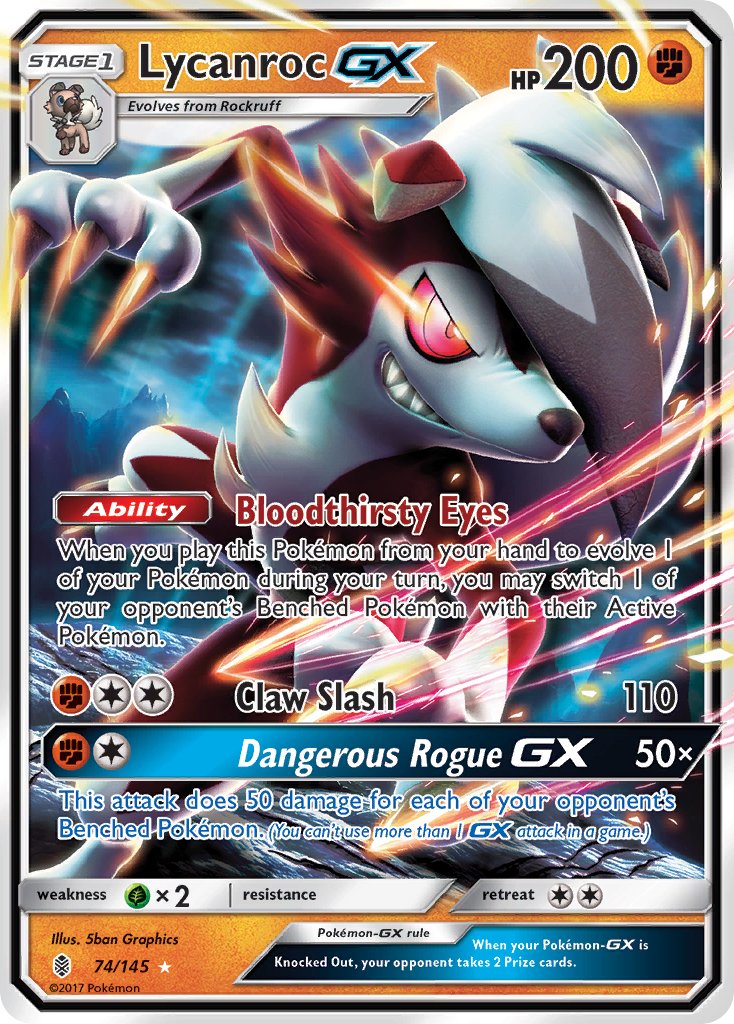 |
Sun & Moon: Pokémon-GX
- This is more akin to the original Pokémon-ex types, as Pokémon-GX can evolve from prior Pokémon, and knocking them out nets the opponent 2 prizes instead of 1 (this is the “GX Rule”).
- However, Pokémon-GX have a unique feature: they have a single “GX Attack” which can only ever be used once per game. ANY “GX Attack” can only be used once, so choose wisely!
- DESIGN: Using normal evolution is fine, but they need to include a special “GX” icon after its name. Furthermore, its GX Attack will need to have a special shade of blue connected to it, along with the “GX Rule” in its flavor text box. Finally, Pokémon-GX cards have this thin black border where each of the four corners are cut at a 45-degree angle.
|
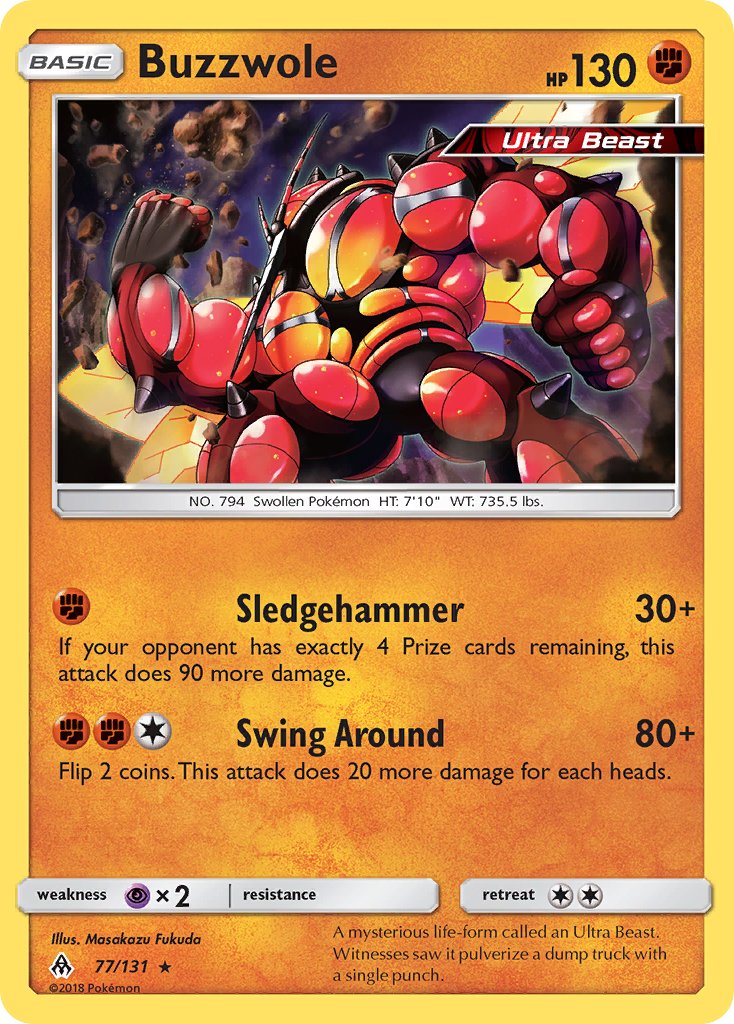 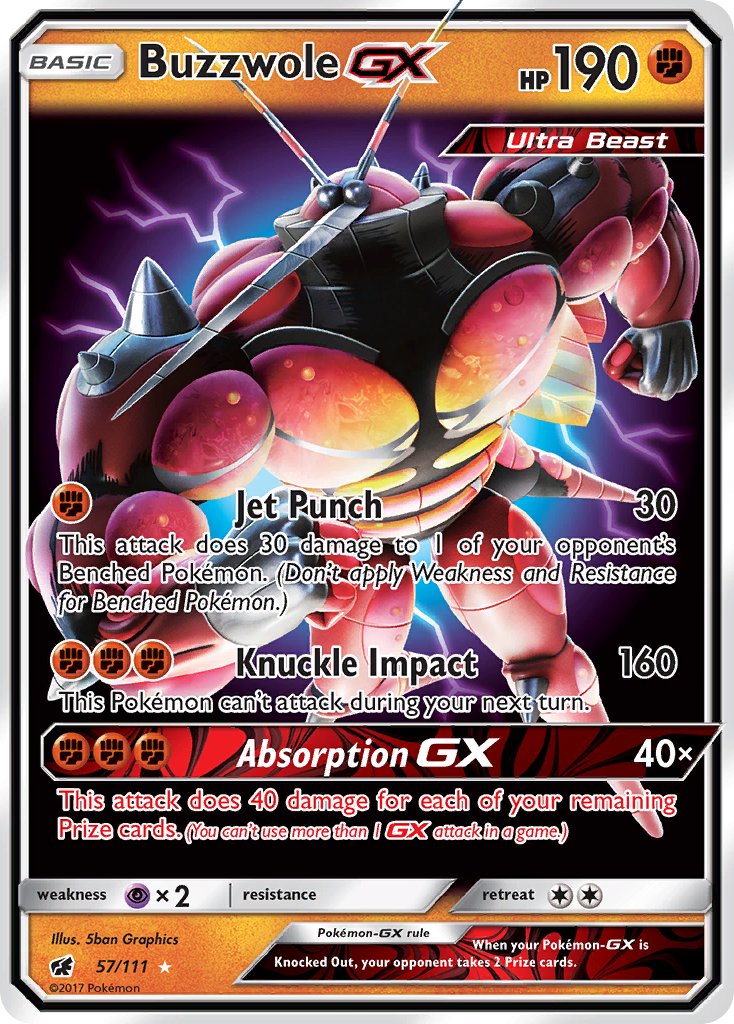 |
SM Crimson Invasion: Ultra Beast cards
- Like Team Plasma cards, Ultra Beast is simply a designation or card category, allowing you to search for or otherwise target Ultra Beast.
- One design element incorporated into Ultra Beast attack—although this is not actually part of it’s actual ruling but rather something that these cards all share—is that their attacks or abilities involve prize cards, like doing extra damage based on how many prize cards drawn, etc. There is nothing technically requiring this, it’s just something that happened which gives them a sort of flair or identity.
- DESIGN: Ultra Beast have a special red-colored text bar under the Pokémon’s HP. This influences other elements, such as if it’s a Pokémon-GX, making the GX logo and GX attack red instead of blue.
- Undoubtedly, if one decides to design a LV.X Ultra Beast, then the LV.X icon would be colored red insted of gold.
|
 |
SM Ultra Prism: Prism Star
- Prism Star cards add limits to deck building; similar to Shining Pokémon and ACE SPEC cards, you’re only allowed one Prism Star card of the same name per deck. This means that while you can have only one, say, “Giratina PRISM” card in your deck, you can still have multiple other “Prism Star” cards in it.
- Finally, if a Prism Star card is placed in the discard pile from anywhere, it’s placed into the Lost Zone instead (basically Pokémon’s Exile)
- DESIGN: border is all black, and a Prism Star logo is placed both next to the card’s name and as a water mark in the text field. There is also a “Prism Star” rule box placed beneath the card’s artwork
|
 |
SM Team Up: Tag Team-GX
- This is more like a variation of the Pokémon-GX format more than anything; the theme of this is that it combined two Pokémon together into a “Tag Team” with extra stats and power. However, unlike normal Pokémon-GX, Tag Team-GX nets your opponent THREE prizes if they’re knocked out instead of just two; this is the “Tag Team rule”.
- Since three prizes are drawn, the theoretical limit to its HP could be 360.
- Because of the “two Pokémon on one card” situation, all Tag Team-GX cards are Basic Pokémon by default, even though Pokémon-GX cards can be of any stage.
- That said, I’m sure there could be a creative use of a Tag Team-GX, like maybe “Vileplume & Bellossom Tag Team-GX” which evolves from a Gloom, or a “Slowking & Slowbro Tag Team-GX” which evolves from a Slowpoke. But this is a creative decision, not one ever use in the game itself.
- That said, I’m sure it’s possible to simply have a NORMAL “Tag Team” card, that isn’t a Pokémon-GX. However, the question is… if it’s not a Pokémon-GX, then how many prizes are drawn?
- Maybe one? Since the Tag Team rule says three prizes are drawn, which is because you’re drawing prizes for knocking out the combined forces of a Pokémon-GX (2 prizes) and a regular Pokémon (1 prize). Get rid of the Pokémon-GX means getting rid of the extra two prizes drawn.
- Maybe two? Because since they’re not Pokémon-GX, then knocking out two Pokémon (even if it’s on one card) should get you two prizes, right?
- Maybe three? The three prizes thing applies regardless of it’s a Pokémon-GX or not, because it’s called the “Tag Team rule”, not the “Tag Team-GX rule”.
- I personally think that, for non-GX “Tag Team” cards, people should just draw two cards, one for each Pokémon on the card. However, somehow the name “Tag Team rule” will need to be changed.
- DESIGN: Tag Team-GX have the 45-degree borders of normal Pokémon-GX cards, as well as a fancy yellow “grip tape” border on its upper-left and bottom-right corners. Finally, the word “TAG TEAM” is placed beneath its name.
|
  |
Sword & Shield: Pokémon V and Pokémon VMAX
- Another new gen, and another major Pokémon type. Pokémon V brings the “Basic Pokémon only” format of Pokémon-EX from BW, and like them, two prizes are drawn upon a Knock Out (this is the “V rule”).
- But unlike Pokémon-EX, Pokémon V was built with an evolution in mind: Pokémon VMAX. They can be of either Dynamax or Gigantamax forms, but this seems to be a purely asthethic choice (based more on their video game forms) as there is otherwise no ruling difference between the two. Pokémon VMAX also have the “VMAX rule”, which allows three prizes to be drawn upon a Knock out.
- DESIGN: Both Pokémon V and VMAX forms have a giant black V in its upper-left corner, as well as V flipped 180 degrees in the opposite lower corner. They also have black borders and black-colored weakness/resistance/retreat cost bar. Their card images are also not limited to a normal picture frame and break out filling much of the card.
- Pokémon V cards, specifically, have a black-colored white-bordered “V rule” box, black HP background, and a V icon after its name.
- Pokémon VMAX cards, on the other hand, have a white-colored black-bordered “VMAX rule” box, more rainbow sparkley bits, and a VMAX icon after its name. They can also have either “Dynamax” or “Gigantamax” placed under its “Evolves from XXXX V” rule text.
|
 |
SwSh Vivid Voltage: Amazing Pokémon
- These are cards with a more aesthetic difference, but function as normal cards. Specifically, they have a rainbow-colored background which looks like a splash of very colorful paint which also spreads beyond its picture borders.
- Furthermore, the card’s attack costs for these cards use three Energy types which are not usually part of its normal costs, such as a Raikou with an attack that costs ZGZLZM. The attack also has the word “Amazing” in it somewhere.
- Finally, its rarity is a special “A” placed over a drop of rainbow-colored paint.
- DESIGN: Nothing, other than the rainbow painty background, the “Rainbow A” rarity, and the “Amazing” attacks which use various Energy type costs.
- That random smell of an eraser dark brown gelly reminds me of Kindergarten!
|
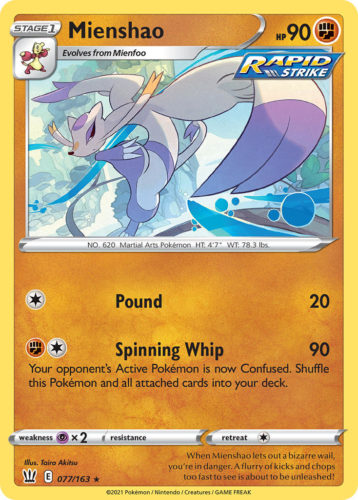  |
SwSh Battle Styles: Rapid Strike, Single Strike
- Similar to both Team Plasma and Ultra Beast card, both Rapid and Single Strike cards are simply designations, a card category that allows you to search for or otherwise target Rapid or Single Strike cards.
- For example, Rapid Strike Energy can only be attached to Rapid Strike Pokémon, giving them two ZW and ZF Energy of any combination. Attaching Rapid Strike Energy to anything that ISN’T a Rapid Strike Pokémon causes it to be discarded.
- Similarly, there are cards like (Rapid Strike) Octillery which allow you to search for any Rapid Strike card, be it a Pokémon, Energy or Trainer card.
- Since this is a card category, neither Rapid nor Single Strike cards have any benefits or other rulings in-and-of-themselves. Their card value comes in the kinds of synergy other cards of the same category bring to the game.
- DESIGN: Rapid and Single Strike cards look like any other card, other than the addition of a “Rapid Strike” or “Single Strike” icon in the upper-right corner of the card’s artwork.
- One optional consideration is adding “Rapid Strike” or “Single Strike” to the Pokémon’s name, if you wish to control how it evolves. For example, the aforementioned (Rapid Strike) Octillery is technically still only called “Octillery”, which in turn evolved from a (Rapid Strike) Remoraid. This means that a NON-Rapid Strike Remoraid simply named “Remoraid” can evolve into (Rapid Strike) Octillery, including a hypothetical (Single Strike) Remoraid. Therefore, one way to control this is to ACTUALLY name a Pokémon “Rapid Strike Remoraid”, which in turn can only evolve into a “Rapid Strike Octillery”. This is exactly what happened with Urshifu, with speficially named “Rapid Strike Urshifu V” and “Single Strike Urshifu V” only able to evolve into their respective VMAX forms because of their specifically stated names.
- Again tho, this concept of specifically naming your Rapid or Single Strike Pokémon to prevent unwanted evolutions is purely optional and not required.
|
|
|
|
|
|
|
|
|
PHEW!! It took a while, but that basically covers some 15-20 years of Pokémon TCG card-type evolution (no pun intended), though there may still be one or two minor card types I might have missed.
One important note I need to make about these card types is that, while there is some level of internal consistency within the types, there isn’t much connection or lineage between them. Like, there are several different special card types that allow opponents to draw two prizes upon a knock out, but they otherwise have zero mechanical connection between them. Heck, there are TWO card types with “Ex” in its name, but are technically and mechanically separate card types; for instance, Pokémon can evolve to a Pokémon-ex (though nothing can evolve FROM them), while Pokémon-EX are all Basic Pokémon and can only evolve to Mega Pokémon-EX. Furthermore, Trainer cards which say something like “Search your deck for a Pokémon-ex card” aren’t applicable to Pokémon-EX (or any other special Pokémon type for that matter), so this also creates a temporal limit to the usefulness of those cards.
Then there’s the whole interaction part, like which card can evolve into what… which I’ll cover below.
Ways to Evolve
Because of these different card types and styles, they may actually affect how a card can evolve, IF it can even evolve to begin with. This section covers exactly which card can be placed onto what.
- Basic (only; they generally can’t evolve into anything else)
- Basic Shining Pokémon
- Basic Pokémon ☆
- Basic Pokémon-ex
- Basic Pokémon-EX
- initially; in later sets they were made to evolve into Mega Pokémon-EX, but means that unless a Mega Pokémon-EX exists for it, it won’t evolve into anything
- Basic Pokémon-GX
- Basic Tag Team-GX
- Baby > Basic > Stage 1 > Stage 2
- Prime Pokémon are neither special nor different than normal cards, they just look different. So a Phanpy can evolve into a “Prime” Donphan, only because it’s just a regular Donphan.
- Crystal Pokémon are normal Pokémon—whether Basic, Stage 1 or 2—other than the fact that they are Colorless-types and have the Crystal Type ability.
- Delta Species Pokémon are normal Pokémon, just with varying types. There is no prerequisite that a Pokémon needs to share types with its evolutions.
- Formes—like “Alolan XXXX” or “Galarian XXXX”—are part of a Pokémon’s name and therefore affect evolution.
- Subsets include:
- Owner’s Basic > Owner’s Stage 1 > Owner’s Stage 2
- this includes Pokémon SP and Team Aqua/Magma forms, but NOT Team Plasma forms
- Dark Basic > Dark Stage 1 > Dark Stage 2
- Light Basic > Light Stage 1 > Light Stage 2
- Assume both “Baby > Basic”, Owners, Dark and Light Pokémon, etc etc evolution concept applies to everything below as well.
- So if a “Baby Misty’s Azurill” ever existed, then it could only evolve into a “Basic Misty’s Marill”. Same with “Baby Dark Igglybuff” only evolving into a “Basic Dark Jigglypuff”
- Basic > Stage 1 Pokémon-ex
- Basic > Stage 1 > Stage 2 Pokémon-ex
- There were Basic Pokémon-ex, but Pokémon-ex basically represent an end form to which nothing can evolve from.
- To be specific, if there was ever an Bulbasaur ex, that would be it. Similarly, a hypothetical Ivysaur ex would NOT be intended to evolve from from that “Bulbasaur ex“, only from a normal “Bulbasaur”. The same goes with Venusaur ex, which would’ve only been intended to evolve from a normal Ivysaur, not an Ivysaur ex. This is because the “ex” is part of their name.
- If you wanted to invent an entire line of Pokémon-ex like that—Bulbasaur ex, Ivysaur ex, Venusaur ex—then they would need to specifically state “Evolves from Bulbasaur ex” and “Evolves from Ivysaur ex“. However, given that players expect Pokémon-ex to evolve from normal Pokémon, this might cause some confusion.
- Basic > Lv.X
- Basic > Stage 1 > Lv.X
- Basic > Stage 1 > Stage 2 > Lv.X
- Technically Lv.X is not an evolution, but it does also represent an end form to which nothing can evolve from
- That said, I guess it’s possible for a Lv.X Pokémon to evolve—say a Lv.X Pikachu evolving into a plain ol’ Raichu—seeing as Lv.X is not an evolution nor part of its name, therefore technically a Raichu evolution card is still being placed on a Basic “Pikachu” card. But there were never any Lv.X cards made which could be placed on a Pokémon which could then evolve, so this concept has never been tested.
- Basic Pokémon-EX > Mega Pokémon-EX
- Only Mega Pokémon-EX have ever existed, and have therefore only been designed to evolve from Pokémon-EX and be Pokémon-EX themselves.
- However, there is no theoretical reason why normal “Mega Pokémon” can’t exist on their own, or evolve from other card types. Therefore, it’s possible for either a Basic, Stage 1 or Stage 2 to “Mega Evolve”, as the card itself will specifically state what you can place the Mega Pokémon Evolution card onto (for example, “Put M Pidgeot-EX on the Basic Pokémon-EX”)
- The plan for this is to simply do normal Mega Evolutions, like how they were in the video games; like a normal Kangaskhan evolving into Mega Kangaskhan.
- Theoretical Mega Evolution forms include (but aren’t limited to):
- Basic Pokémon-ex > Mega Pokémon-ex
- Basic > Stage 1 Pokémon-ex > Mega Pokémon-ex
- Basic > Stage 1 > Stage 2 Pokémon-ex > Mega Pokémon-ex
- Basic > Mega Pokémon
- Basic > Stage 1 > Mega Pokémon
- Basic > Stage 1 > Stage 2 > Mega Pokémon
- Basic > BREAK
- Basic > Stage 1 > BREAK
- Basic > Stage 1 > Stage 2 > BREAK
- BREAK evolutions represent an end form to which nothing can evolve from
- They only seem to evolve from normal Pokémon, not Pokémon-EX or Mega Pokémon.
- Ruling-wise, BREAK evolutions only simply append extra attacks to the existing Pokémon, so it’s theoretically possible for there to be a Pokémon-EX BREAK… but that’s really overdoing it.
- That said, I MIGHT, just for shits-and-giggles, make a perfectly legal but completely balls-out nonsense Pokémon card which is a Mega Pokémon-ex BREAK, as in:
- Basic > Stage 1 Pokémon-GX
- Basic > Stage 1 > Stage 2 Pokémon-GX
- Like with Pokémon-ex, there are Basic Pokémon-GX, they just can’t evolve as Pokémon-GX represents an end form
- Basic Pokémon V > VMAX Pokémon VMAX
- Kinda redundant name, but… the first VMAX is the stage, the second VMAX is its type.
Of course these rules are only here if you want to focus on authenticity and rule accuracy. But if you want to make a Shining Pokémon evolve into a Mega Pokémon LV.X, go for it; don’t let me stop you! That’s the fun of making Pokémon fake cards: your dream cards can come to life.
But that said, you can kinda see why the Pokémon TCG, after the end of one generation and the start of the next, tends to basically toss its previous card types down the Memory Hole; they want you to keep moving with the game instead of trying to hold onto what happened in the past. I’m not here to debate whether this is good or not, just that, clearly there is a temporal limit to the relevancy of these cards. But then again, I guess this happens all the time in healthy card games; afterall, when was the last time Magic: the Gathering made a card that utilized Flash?
So Far, So Good…!
This is all I have to share with you for now… there’s still a LOT to cover in getting you up to speed. But I wanted to at least get some foundational work set up so that I can use it to build off of later.
That said, perhaps my next major task for this page is to provide picture examples of the various blank styles and card types, so you can understand what I’m actually on about.
Until then, hopefully I’ve given you some new stuff to chew on, so that you might be better prepared to get back into the faking game. Sound good? Good times.
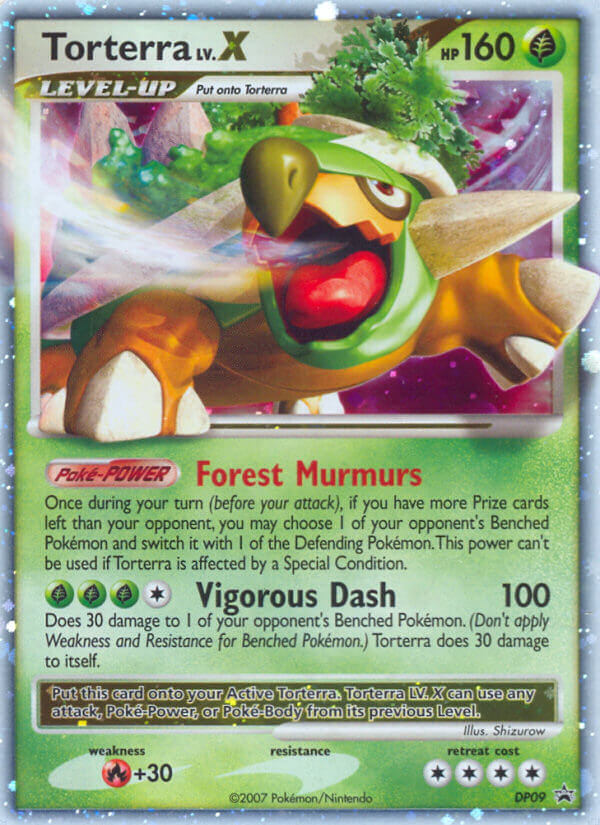
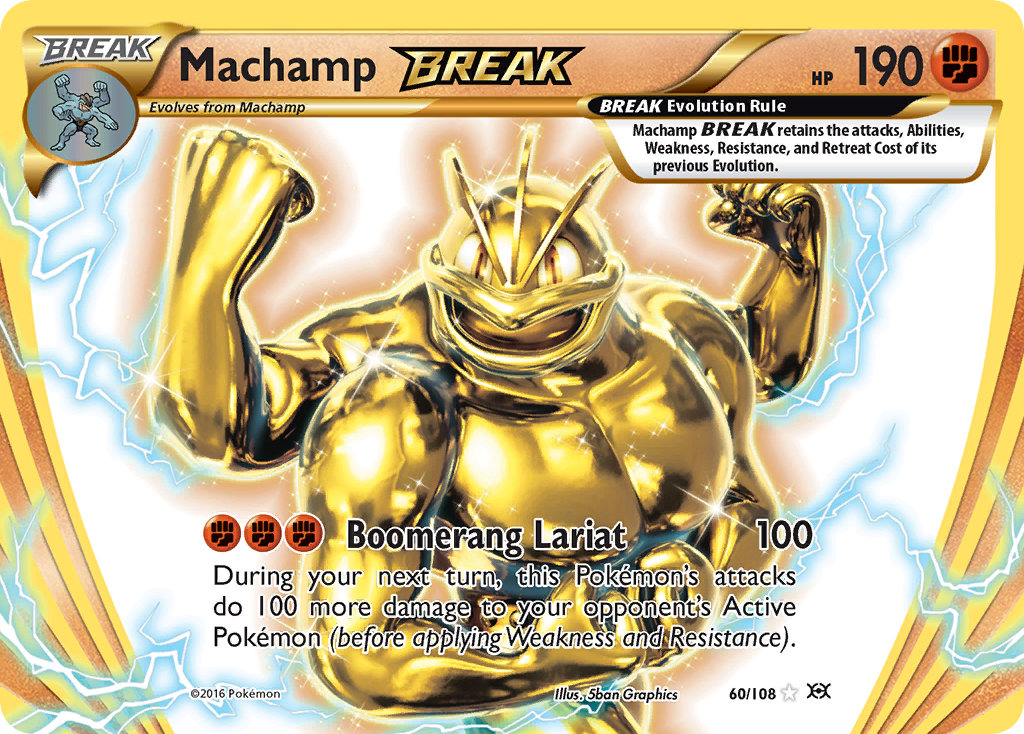

 Well, don’t worry, your ol’ pal Uncle Nick15 is here to help explain everything. Hopefully by the end of this you’ll get a good idea of the kind of stuff you can do with this game and hopefully inspire you in new and exciting ways. That said, this page is still a work in progress, but I’m planning on covering all the different card types and styles. Anyways, let’s get crackin’!
Well, don’t worry, your ol’ pal Uncle Nick15 is here to help explain everything. Hopefully by the end of this you’ll get a good idea of the kind of stuff you can do with this game and hopefully inspire you in new and exciting ways. That said, this page is still a work in progress, but I’m planning on covering all the different card types and styles. Anyways, let’s get crackin’!














































